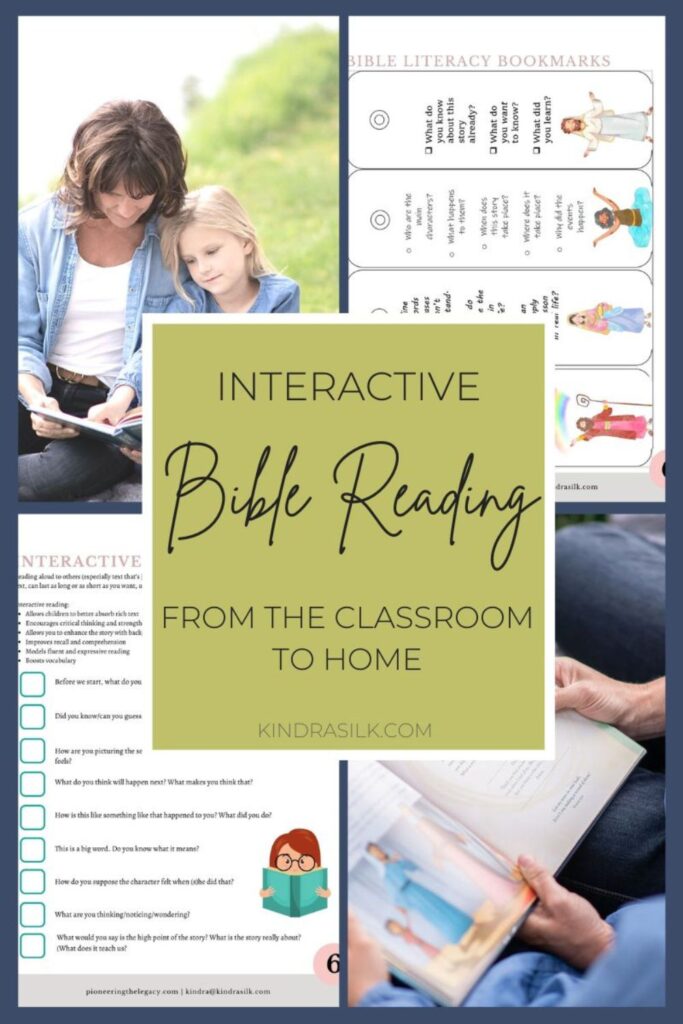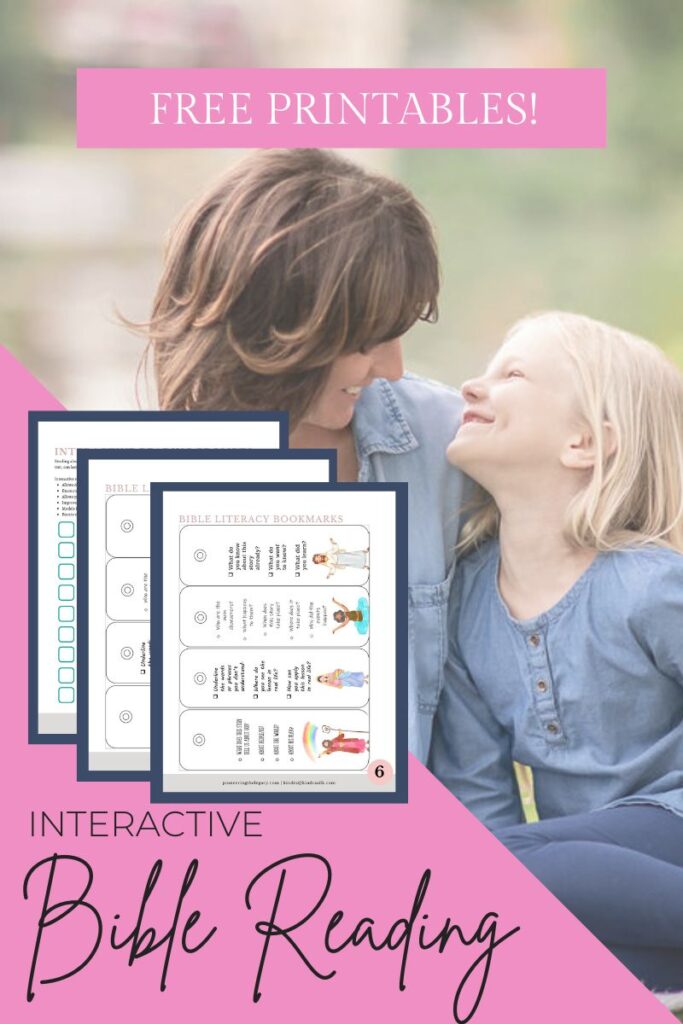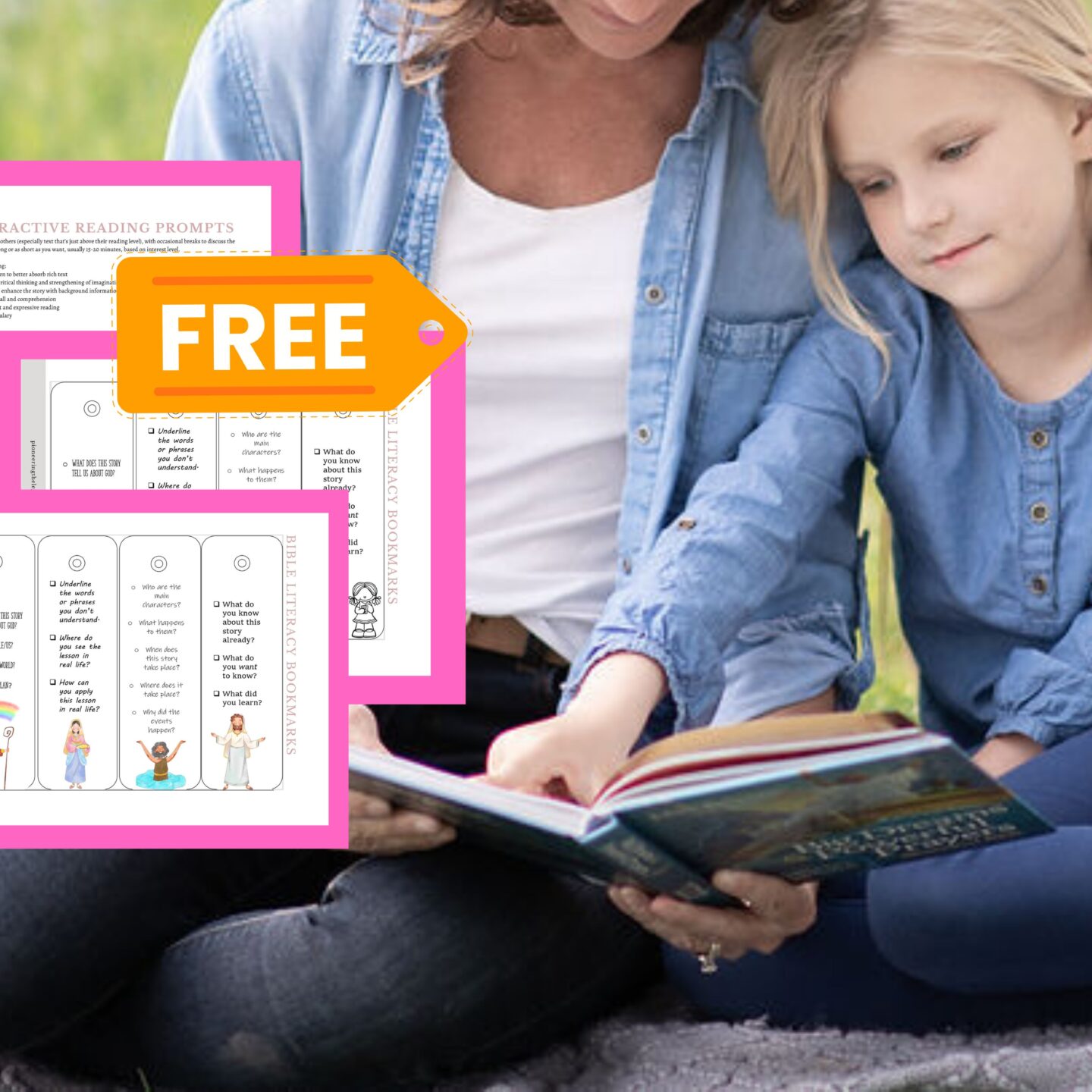What Is Interactive Reading?
What is “interactive reading?” you ask. Only the simplest and best way to supercharge your children’s Bible storytime, IMHO.
Teachers and librarians will be familiar with this effective strategy. They use it all the time in group settings. But we non-teachers (or in my case, ex-teacher) can also use it at home with our children—and in their Bible storytime.

Why Would I Want to Use It?
Interactive reading is a fantastic way to pull a child (and yourself) into some fun story time for both of you. And to liven up any story. 😉
It has tons of benefits, especially for kids growing their reading and literacy skills. And definitely for those struggling to enjoy and understand the Bible.
Some of the key benefits:
- Improved comprehension and retention
- Increased vocabulary and understanding
- Enhanced analyzing and critical thinking
- Improved social skills
- Increased motivation to read
How Does It Work?
- Interactive Bible reading prompts active involvement with the stories. By asking and answering questions, making predictions, and making connections to their own experiences, kids can better comprehend the stories—and much more deeply.
- It exposes kids to a wide range of words and concepts. By discussing them, children expand their vocabularies, improve their language, and stretch their conceptual thinking.
- Interactive Bible reading encourages children to think critically about the stories—and make connections to their own lives and the world around them. Wouldn’t God want us to raise critical thinkers? I heard someone say: The unexamined thought is not worth thinking. And it really resonated. It’s especially true when it comes to the Bible. Because there are a lot of misunderstandings, arguments, splits, and divisions. Our budding spiritual powerhouses should be able to stand on their own feet and back up why they think what they think. Interactive Bible reading is a simple way to start small for BIG gains over time.
- This type of reading involves chatting and analyzing with the adult reading. My son was diagnosed with cancer at age two. We spent a lot of time in medical facilities. You wouldn’t believe the vocabulary that little boy had when he finally began to talk. Neutropenic was one of his first words. Time spent in big conversation with adults yields amazing vocabularies.
- Interactive Bible reading can foster a happy, curious nature and a greater love of reading—if the grown-up is leading it in a fun way.

How Do I Do This Interactive Reading Thing?
Interactive reading for children’s Bible stories is a cinch. Before you know it, it will come second nature. You might even be doing some of these already.
Here are some ideas and prompts you can use during your children’s Bible reading time:
- Ask open-ended questions: Ask your child questions about the Bible story that require more than a yes or no answer. For example, “What do you think Deborah is feeling right now?” or “Why do you think God made that decision?” Or before the story even begins: “What do you think The Fall is going to be about?”
- Make predictions: Encourage your child to make predictions about what will happen next in the Bible story. For example, “What do you think will happen to Jonah in the next chapter?”
- Connect to personal experiences: Help your child make connections between the Bible story and their own life experiences. For example, “Have you ever felt like Cain in the story?” For anyone with pride—and that’s all of us—the answer is yes.
- Visualize the story: Encourage your child to visualize the Bible story by asking questions like, “What do you think Jesus looked like?” or “What did the town of Shiloh look like?” You use clues in the text and can even hop online and look up places or reconstructions. Feel free to incorporate all the senses: What do you think that smelled, tasted, felt, or sounded like?
- Summarize the story: Ask your child to summarize what they have read so far in their own words. This can help them better understand and retain the information.
- Role-play the story: Sometimes, acting out scenes from the story can really help understand the characters and their dilemmas. But don’t let them get too carried away! Hint: don’t try this at bedtime!
- Ask for assessments: Ask your child for his or her thoughts on the meaning of the story, such as the characters, the plot, or the ending. Ask what it means for us today. How can we best use this meaning in our own lives?

Your Turn!
Did I sell it enough for you to give it a try? It’s easy, fun, beneficial, and needed if you want to go deep and make it stick. You are going to pack a punch and save yourself time in the end. Your child is building a firm foundation on which to build and build. A shack will do for a while, but I’m shooting for something along the lines of a well-built log cabin or Frank Lloyd Wright’s Falling Water—something both sturdy and beautiful.
Remember, you’re in charge here. You have all the power to make this reading session fun and captivating—or bone dry. Considering you know your child best, I bet you’ll hit the ground running. And I challenge you to inspire a healthy dose of chuckles between you both!
To get you started easily, I’ve made you an Interactive Reading Prompts printable and coordinating bookmarks to color! But I bet you already knew that 😉
Can’t wait to hear how you like it—and how your child loves it. Enjoy!

P.S. If you like this post, you might like this one and its free printable: Literal of Figurative: Teaching Kids the Bible.


